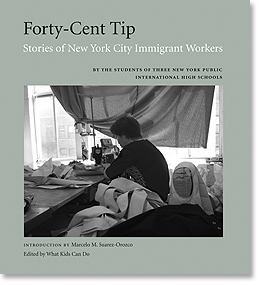 Kariela Almonte, a senior at Manhattan International High School, talks about her experiences working on Forty-Cent Tip
Kariela Almonte, a senior at Manhattan International High School, talks about her experiences working on Forty-Cent Tip
At our first meeting with 10 other classmates and our two teachers, we discussed the process of interviewing people and the purpose of the project. We brainstormed possible questions for the interview and ways in which to make the interviewee comfortable and open to talk to us about their personal experience. We often met as a group to share our interviews and experiences as interviewers. I learned a lot by reading my classmates' interviews and sharing ideas with them. Our goal in this project was to get to know in depth immigrant workers and their experiences at work. We wanted to show stories that talked to people about the harsh working conditions of these immigrant workers in NYC.
Many of us interviewed a family member or a friend. But it was difficult to get people comfortable with the questions and get the interview going. Some questions included: Have you ever been discriminated against at your job? Do you have any days off? Do you like your job? How long have you been doing this? Do you have any goals or plans for the future?
Everyone in the project developed his/her own questions. But as a group we all had basic questions we asked our interviewees. Sometimes we took questions from each other. We started by asking their names, where they came from, why did they decide to come to the US, if they left any family members behind, etc. Overall, we asked things that would draw them into the conversation. We wanted to have a conversation not a Q/A session. It is important to listen and respect the person who's talking in an interview. Never interrupt the person. At school speakers came to help us and gave us workshops about taking photographs. For example, if you interview a soldier, you should want to portray something significant about that person. They gave us a lot of freedom too. We, the students, were in charge of the project but our teacher Annie and mentor James were very helpful in directing us in every step. They let us have choices and that was really nice. They also gave us tape recorders and told us not to put it too close to the person's mouth because it would make the person uncomfortable.
Many people in the project were interviewing men. I've always wanted to do something different. Many times women are discriminated and viewed as inferior to men and I wanted to show a story that would change reader's view about women and what women are capable of doing in society. That's why I chose to interview my mother. She used to be a taxi driver. A dangerous occupation that it's often viewed as a men's job.
It was kind of weird to interview my mother. We don't have a close relationship. I have not lived with her for many years. I got closer to her when I came to this country. At first, I told her that I was going to interview her but she refused. Later, she accepted but I had to push her a lot. And in the end she gave up. It was hard because she is not the kind of person that would sit down with you and talk about issues.
She told me that she was discriminated by other women too. A lot of women saw her and they did not want to get in the taxi because she was a woman. While my mother was saying that, she was really mad. "I am a woman as they are, so why should I be discriminated by them? I think they should feel proud of me," she told me.
Using the tape recorder, I played the interview to my mother. We were laughing because it's really funny to hear your voice—it sounds different on the tape recorder. She started to laugh because she couldn't believe she said all that. I am not a photographer but it was not difficult to take good photos. I took about 5 pictures. In the photograph, you are not just looking to photograph a person. Through a photograph, you are looking to portray something important about that person. My mother did not want to be photographed. I caught her in a perfect moment when she was relaxed and talking to friends.
Through this project, I learned to translate from Spanish to English, transcribe, and organize important ideas from an interview and make it into a story that would draw readers. Sometimes I had a hard time choosing what to include. We wanted to focus mostly on people's working experience in the U.S. and thus we had to cut a lot.
Sometimes you need to be very careful when you translate because you can lose the meaning of the thought. I had to use the dictionary. I wanted to find easy words that people could relate to. I wanted to write the story in a simple way so that everyone could understand it and relate to.
At school, we had a small gathering and we showcased our projects to the public. After reading my mother's story, many people came to me and said that my mother was "tough." I did not think of that before. I felt proud of my mother. I got to know my mother a little more through this project. Sometimes you think that you know a person very well but maybe you don't know that person as much. It is once you sit down and talk that you begin to know that person better. Then that person starts to open up and share feelings and stories that were hidden inside them. I felt the project was an opportunity to get closer to my mother.
Click here to return to Forty-Cent Tip.


